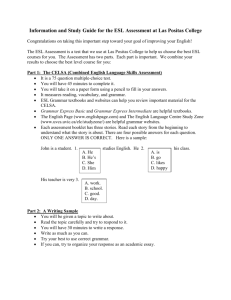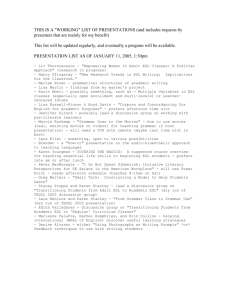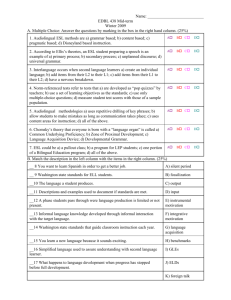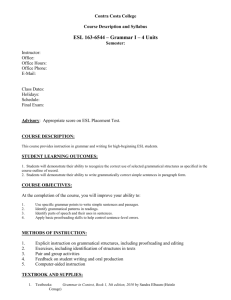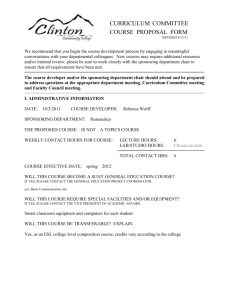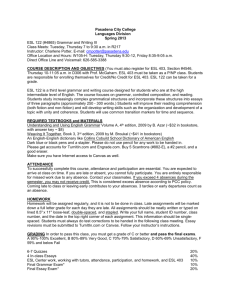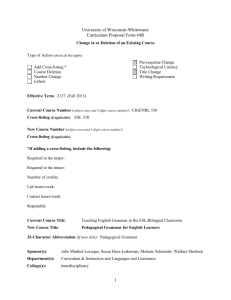English as a Second Language Endorsement (Graduate Program)
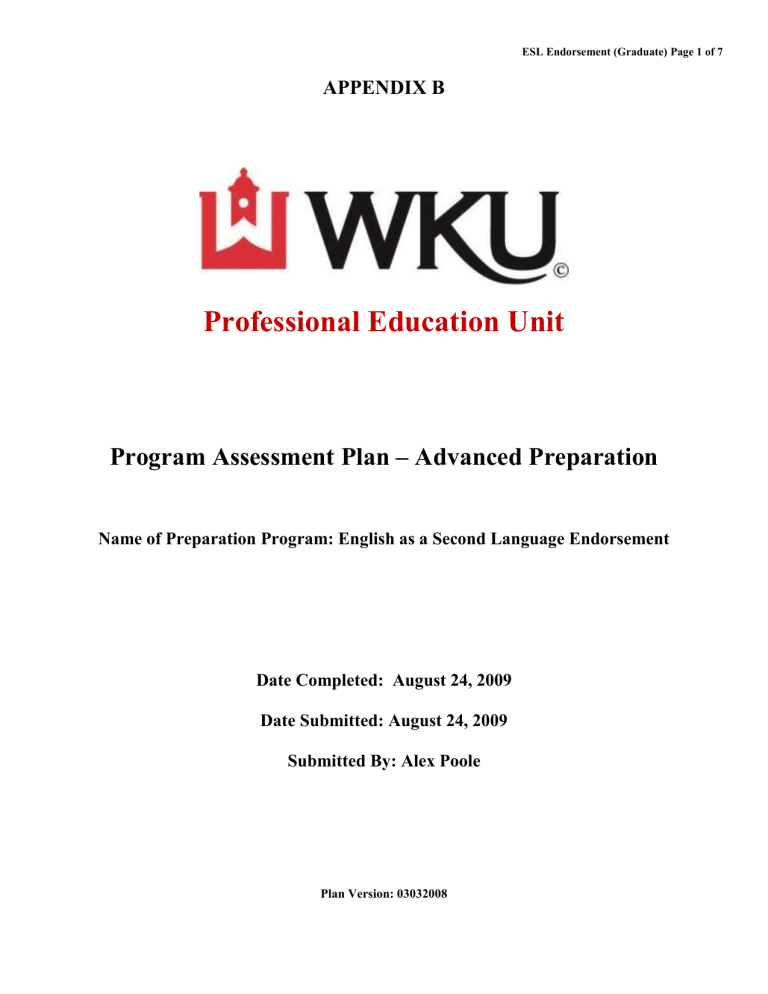
APPENDIX B
ESL Endorsement (Graduate) Page 1 of 7
Professional Education Unit
Program Assessment Plan – Advanced Preparation
Name of Preparation Program: English as a Second Language Endorsement
Date Completed: August 24, 2009
Date Submitted: August 24, 2009
Submitted By: Alex Poole
Plan Version: 03032008
ESL Endorsement (Graduate) Page 2 of 7
Critical Performance Assessment Alignment Matrix (Current: August 2009)
Advanced Preparation Professional Education Program (English as a Second Language)
Kentucky Teacher Standards
Courses I
Content
Knowledge
II
Designs/Plans
III
Learning
Climate
IV
Manages
Instruction
V
Assessment
VI
Technology
VII
Reflections
VIII
Collaboration
IX
Professional
Development
X
Leadership
ENG 407G
ENG 408G
Exam/Essays
Exam/Research
Paper
Phonological/
Syntactic/
Morphological/
Semantic
Analyses
Analysis/
Reflection on
Language Use/
Development
Exam/Essays
Exam/Research
Paper
ENG 565
Critical Reviews/
Blackboard
Discussions
Lesson Plans
Critical
Reviews/
Observations
Critical
Reviews/
Observations
Critical
Reviews/
Blackboard
Discussions
Website
Review/Critical
Reviews
Blackboard
Discussions
Critical
Reviews/
Blackboard
Discussions
Professional
Development Plan
Critical Reviews/
Blackboard
Discussions
ENG 566
Critical Reviews/
Blackboard
Discussions/
Research
Paper/Interview
Research
Paper
Critical Reviews Critical Reviews
Short Essays/
Blackboard
Discussions
Short Essays
ENG 405G Portfolio Portfolio Portfolio Portfolio Portfolio
Article
Summaries
Short Essays Book Review Book Review Book Review
English 407G
This class gives students the skills to an analyze the syntax, morphology, sound system, and semantics of English and other languages in order to address
difficulties in second language learners’ development in these areas. Students learn these skills via the course text, articles, class handouts, and digitalized sounds systems for English and other languages from websites such as the International Phonological Association, Ethnologue, and the American Dialect
Association. Students are required to do phonological, phonetic, syntactic, morphological and semantic analyses using English and other languages. Students are expected to use MLA or APA style when citing sources. These exercises prepare them for the exam, which asks them to do similar things, in addition to discussing their implications for ESL students’ grammar, pronunciation, and word use. Finally, students are required to do research based essays in which they extensively analyze a language using materials from the library and the Internet in any of the four major content areas (syntax, morphology, sound system, and semantics) in order to reinforce principles in the class and recognize what difficulties may occur in these areas with their ESL students.
English 408G
Students reflect upon how first and second language languages develop cognitively and socially inside and outside of the classroom, and how language varies according to ethnicity, gender, region and historical time period. They do this via homework exercises, pop quizzes, exams, and a library- based research paper. In homework assignments, students are required to analyze and reflect on how a particular aspect of language use and development (ethnicity, gender, region, and historical time period) arises, functions in real time, and is viewed by various members of society such as peers, parents, and teachers. These assignments require students to utilize articles, class handouts, and audio files found on Blackboard and the Internet. Exams require students to display an in-depth knowledge and understanding of the issues covered in homework assignments.
In the research paper, students must extensively treat one aspect of language use and development using print library sources, electronic databases, and professional linguistic websites. Topics that students may select include the value of
ESL Endorsement (Graduate) Page 3 of 7 individual and societal bilingualism, how bilingualism functions at the cognitive level, the link between first and second languages, and how male and female language usage differs at the cognitive and social levels . APA style must be used when citing sources in assignments and the paper.
English 565
In this course, students cover a wide variety of issues associated with second language acquisition and teaching, including the cognitive, emotional and social issues associated with child/adult L2 acquisition in naturalistic and classroom environments; the methods and materials used to teach ESL; strategy instruction in the L2 classroom; classroom, unit, and standardized testing; the use of technology in ESL instruction; working with mainstream teachers, parents, and the local community; and professional development. They do this via critical chapter/article reviews, weekly Blackboard participation, a professional development plan, a website evaluation, lesson plans, classroom observations, and an error analysis project. In critical chapter/article reviews, students are required to analyze and reflect on the theoretical arguments and instructional implications associated with language acquisition theory, assessment, classroom teaching methods and techniques, and working with mainstream teachers. In Blackboard discussions, they are required to summarize, criticize, reflect on, and exemplify the theoretical arguments and pedagogical implications of the week’s assigned readings and notes. Topics covered in such discussions include b ilingualism, culture, and working with parents. Also, students are required to develop a professional development plan that requires students to evaluate their own knowledge of professional literature, professional organizations, their students’ needs, the institution’s requirements, and develop a plan to address their deficits in these areas. Students also carry out a website review of a major ESL advocacy group (TESOL, AAAL, NABE, etc.) in which they discuss the group’s activities, positions toward L2 learning and instruction, and the quantity and quality of the information presented in the website. Lesson plans require students to plan activities associated with specific L2 skills (reading, writing, grammar, pronunciation, etc.) and integrate local, state, and federal standards into them. Fourth, students observe ESL classrooms in order to get an idea of how practicing teachers use various L2 methods and materials, implement standards, and manage instruction for learners with varying learning goals/needs. Finally, students carry out an error analysis project in which they explain and exemplify the grammatical, orthographical, phonological, and lexical difficulties that learners from selected L1s have when learning English. First languages frequently seen in the
Commonwealth of Kentucky (e.g. Spanish, Russian, Arabic, Chinese, and Korean) are focused on. All sources must be cited using APA style.
English 566
In this class, students learn about the following issues: the different types of English grammar (prescriptive, descriptive, and pedagogical); how ESL learners’ grammar develops in theory and practice; the methods and techniques used to teach ESL grammar; and the methods of evaluating ESL students, in general, and
ESL students’ grammar, specifically. They do this via weekly Blackboard participation, an extensive research paper/project, short response essays, critical chapter/article reviews, and an interview with a practicing ESL teacher. In Blackboard discussions, they are required to summarize and reflect on the theoretical arguments and pedagogical implications of the week’s assigned readings and notes. The 15-page extensive research paper/project is an undertaking in which they are required to discuss specific grammar difficulties that ESL or EFL learners have and exemplify some specific techniques/activities aimed at helping them with these difficulties. This requires a minimum of 10 library sources, and the use of APA style. The short response essays involve doing three, 3-4 page, short response essays based on specific readings. These essays require students to analyze certain issues in-depth or add their highly critical “two cents” to the issue
(s). Part of these essays will involve collaborating with an assigned partner in order to solve a specific problem associated with the topic or reflect on its significance. The following issues are covered: oral/written error correction, problems with assessing the content knowledge of K-12 ESL students, and teachers’ beliefs about teaching grammar. Students must use APA style in these essays. In critical chapter/article reviews, students review ten chapters and/or articles in which they condense the major points of the reading; discuss the pedagogical significance of the reading’s main points/research findings; and point out the weaknesses (content-wise, stylistic, or in any other way) of the reading. They must divide these reviews among the following topics: prescriptive/descriptive/pedagogical grammar; theoretical views on L2 grammar acquisition; approaches and methods to teaching grammar; classroom assessment; and standardized assessment. Finally, students do an in-depth interview with one ESL teacher about the role of grammar in their classroom and in
ESL Endorsement (Graduate) Page 4 of 7 their school’s curriculum. They can pick any grade level (P-12, college, community college, etc.) they wish, but it should correspond to the grade level they teach or plan to teach. They must ask them a minimum of ten questions regarding their training in grammar, their view about the nature of second language grammar acquisition, their opinion on how grammar should be taught, and the difficulties that their students have with grammar.
English 405G
The course gives students practical experience working with ESL students in public schools and other settings (e.g., community colleges, intensive English institutes, and community education programs). Students have the opportunity to apply theories and methods of second language acquisition, practice integrating state/national learning standards in the classroom, receive professional feedback and evaluation, and investigate areas relevant to the classroom such as parent involvement, working with mainstream teachers, professional development, and legislation. Students complete a portfolio which documents 30 hours of ESL teaching in a public school setting. In this portfolio, students must do the following: discuss and reflect upon their students’ grammatical, lexical, and pronunciation difficulties; describe the methodologies they used to help students reach the stated linguistic and/or content goals; and assess students’ learning in individual lessons. In addition, students compose short essays that require them to reflect on specific aspects of their experiences, and write summaries on technology, language proficiency assessment, language rights and laws, and working with parents. They also do book reviews on the rule of culture and identity in instruction, professional development, collaboration, and leadership.
ESL Endorsement (Graduate) Page 5 of 7
Delineation of Unit/Program Transition Points – Advanced Preparation, ESL Endorsement
Transition Point 1: Admission to Education Preparation Programs
Data Reviewed Minimal Criteria for Admission/Continuation
Review
Cycle
Reviewed By
Unit Level Data:
Additional Program Specific Data (if any):
Admission Application
Undergraduate Degree
GAP Score (UG GPA x GRE)
Teaching Certificate
English 104 Introduction to Linguistics; or
English 302 Language and Communication; or English 304 English Language
Completion of application
Evidence of degree
2200+
Evidence of certificate
C or higher in linguistics or grammar course
Each
Month
Graduate
Studies
Transition Point 2: Program Exit
Each
Semester
Program
Director
Data Reviewed Minimal Criteria for Exit
Review
Cycle
Reviewed By
Program Specific Data
Six hours of foreign language
ESL Praxis
Overall GPA of 3.0 or above
ESL course grades
C or higher in coursework
Minimum score of 620
3.0 or above
No more than one course with grade of ‘C’; No course grade at a ‘D’ or ‘F’
Each Year
Program
Director
ESL Endorsement (Graduate) Page 6 of 7
Other Key Data Collection Matrix
Preparation Program: ESL Endorsement (Advanced Preparation)
CF Values Unit-Wide Assessment Program Level Data Collection Points (Courses)
Field Experiences & Clinical
Practice
Final Clinical Experience Summary Information
KTS/Impacts P-12 Student Learning Capstone Assessment
1
ENG 405G
ENG 405G
2 3 4 5
KTS/Dispositions Final Clinical Experience Evaluation ENG 405G
KTS Exit Survey ENG 405G
All coursework in the ESL Program is explicitly focused on linguistic and cultural diversity; thus, the program is inherently diverse in that it prepares candidates to work with students who do not speak English Diversity* Early/Final Clinical Experience Summary Information as a first language and are therefore different from the majority of students in Kentucky.
*Please indicate the course or experience your program uses to guarantee that all candidates work with diverse students.
ESL Endorsement (Graduate) Page 7 of 7
Annual Program Assessment Report Outline (Due September 15)
Academic Year __________
1.
Present your continuous assessment results in the following areas: a.
Admission Data b.
Course Based Assessment Data c.
Clinical Experiences Data – Be sure to include dispositions assessment results,
P-12 student diversity statistics, and results of efforts to ensure all candidates work with diverse students.
d.
Culminating Assessment Data – Be sure to include impact on P-12 student learning data.
e.
Exit and Follow Up Data
2.
Summarize the above results by Kentucky Teacher (Initial Programs) OR Program
Standards (Advanced Programs) AND other key Conceptual Framework values. Be sure to describe what the results tell you about your candidates’ progress toward/proficiency on each standard/CF value.
3.
Summarize your efforts to report and disseminate your results (Unit/College-wide meetings, department/program level meetings, written reports, presentations, etc.).
4.
Summarize key discussions and/or decisions made based on assessment results: a.
Describe any assessment or data collection changes you have made/will make based on your assessment results. b.
Describe any program curriculum or experience changes you have made/will make based on your assessment results. c.
Describe any decisions about group/individual student progress you have made/will make based on your assessment results.

